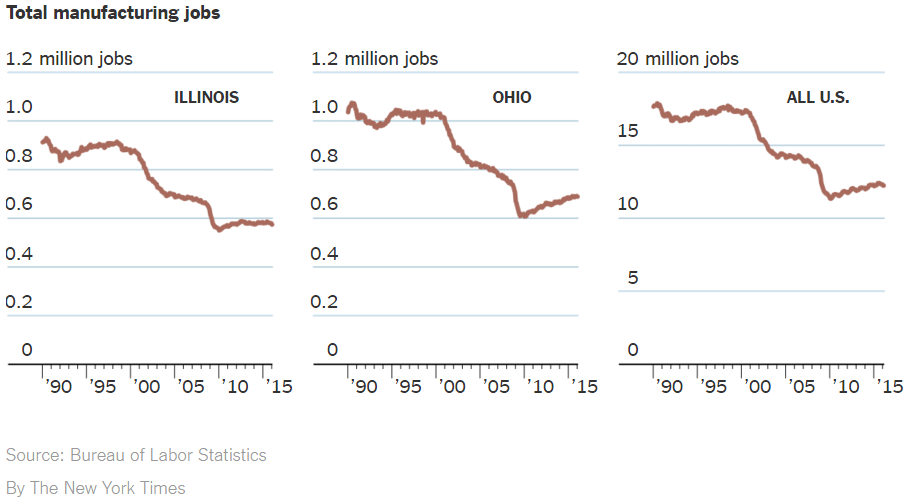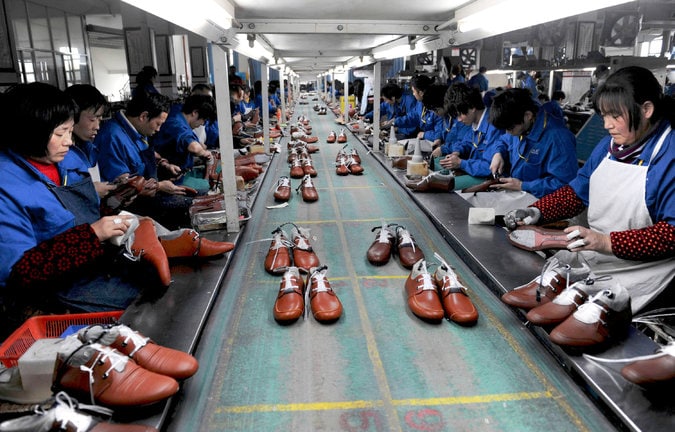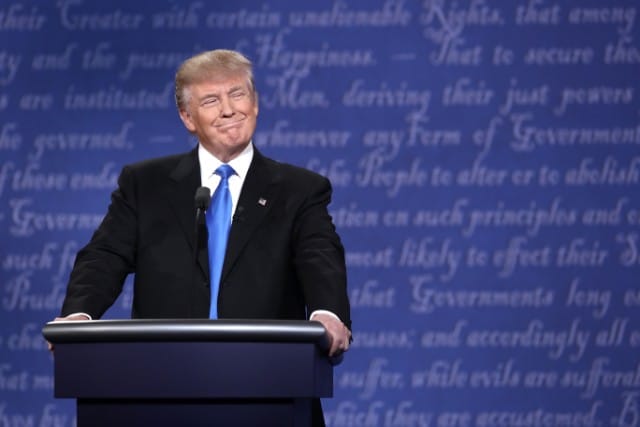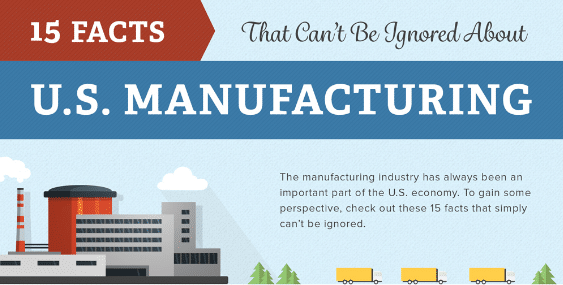On Trade, Angry Voters Have a Point
Were the experts wrong about the benefits of trade for the American economy?
The nation’s working class had another opportunity to demonstrate its political clout Tuesday, as primary voters went to the polls in Illinois and Ohio, Rust Belt states that have suffered intensely from the loss of good manufacturing jobs. Last week, the insurrection handed Michigan’s Democratic primary to Bernie Sanders while continuing to buoy the insurgent Republican candidacy of Donald Trump.
Voters’ anger and frustration, driven in part by relentless globalization and technological change, may not propel either candidate to the presidency. But it is already having a big impact on America’s future, shaking a once-solid consensus that freer trade is, necessarily, a good thing.
“The economic populism of the presidential campaign has forced the recognition that expanded trade is a double-edged sword,” wrote Jared Bernstein, former economic adviser to Vice President Joseph R. Biden Jr.
What seems most striking is that the angry working class — dismissed so often as myopic, unable to understand the economic trade-offs presented by trade — appears to have understood what the experts are only belatedly finding to be true: The benefits from trade to the American economy may not always justify its costs.
In a recent study, three economists — David Autor at the Massachusetts Institute of Technology, David Dorn at the University of Zurich and Gordon Hanson at the University of California, San Diego — raised a profound challenge to all of us brought up to believe that economies quickly recover from trade shocks. In theory, a developed industrial country like the United States adjusts to import competition by moving workers into more advanced industries that can successfully compete in global markets.
They examined the experience of American workers after China erupted onto world markets some two decades ago. The presumed adjustment, they concluded, never happened. Or at least hasn’t happened yet. Wages remain low and unemployment high in the most affected local job markets. Nationally, there is no sign of offsetting job gains elsewhere in the economy. What’s more, they found that sagging wages in local labor markets exposed to Chinese competition reduced earnings by $213 per adult per year.
In another study they wrote with Daron Acemoglu and Brendan Price from M.I.T., they estimated that rising Chinese imports from 1999 to 2011 cost up to 2.4 million American jobs.
“These results should cause us to rethink the short- and medium-run gains from trade,” they argued. “Having failed to anticipate how significant the dislocations from trade might be, it is incumbent on the literature to more convincingly estimate the gains from trade, such that the case for free trade is not based on the sway of theory alone, but on a foundation of evidence that illuminates who gains, who loses, by how much, and under what conditions.”
Global trade offers undeniable benefits. It helped pull hundreds of millions of Chinese out of poverty in a matter of a few decades, an unparalleled feat. It ensured Apple could benefit from China’s ample supply of cheap labor. Consumers around the world gained better-priced, better-made goods.
Still, though trade may be good for the country over all — after netting out winners and losers — the case for globalization based on the fact that it helps expand the economic pie by 3 percent becomes much weaker when it also changes the distribution of the slices by 50 percent, Mr. Autor argued. And that is especially true when the American political system has shown no interest in compensating those on the losing side.
The impact of China’s great leap into the market economy — which drew hundreds of millions of impoverished peasants into the manufacturing sector, mostly making goods for export to the United States and other wealthy nations — is waning. China’s wages are rising fast. Its exports and economy are slowing.
Trade Shock
Manufacturing employment in the Rust Belt and elsewhere in the United States has been decimated by the rise of China as an industrial power and export-driven economy.

Trade with other parts of the world has not been as disruptive. For all the criticism of Nafta, most economists assess its impact on American workers as modest. Trade flows with Mexico were smaller and more balanced than those with China. American manufacturing employment remained fairly stable in the years after Nafta came into force in 1994, plummeting only after China entered the World Trade Organization in 2001 and gained consistent access to markets in the United States.
The Chinese export onslaught, however, left a scar on the American working class that has not healed. That disproportionate impact suggests Washington officialdom might do well to reassess its approach to future trade liberalization. Most important, it points to reconsidering how policy makers deal with trade’s distributional consequences.
It doesn’t mean walling off the United States from the rest of the world, but it does mean learning from the experience of other advanced nations that had a much healthier response to China’s rise.
Germany, for example, not only received a surge of Chinese imports, but also experienced an onslaught of imports from Eastern European countries after the collapse of the Soviet bloc. But it managed to maintain a more balanced trade because German manufacturers increased their exports to all these countries too, offsetting the job losses from import competition.
Mr. Autor suggests that Americans’ low savings rate was a big part of the story, coupled with foreigners’ appetite for accumulating dollar assets, which helped keep American interest rates low and the dollar strong, in that way fueling a persistent trade deficit.
But other factors were at work. Robert Gordon of Northwestern University suggested to me that Germany’s highly skilled workers were harder to replace with cheaper Chinese labor, limiting though not totally eliminating outsourcing. Germany’s stronger labor unions also put up more of a fight.
Washington played its part, too. In their new book “Concrete Economics” (Harvard Business Review Press), Stephen S. Cohen and J. Bradford DeLong of the University of California, Berkeley suggest that ultimately, it was the fault of American policy choices.
The United States might have leaned against China’s export-led strategy, they argue, perhaps by insisting more forcefully that Beijing let its currency rise as its trade surplus swelled. It might have tried to foster the cutting-edge industries of the future, as government had done so many times before, encouraging the shift from textiles to jumbo jets and from toys to semiconductors.
What Washington did, instead, was hitch the nation’s future to housing and finance. But Wall Street, instead of spreading prosperity, delivered the worst recession the world had seen since the 1930s. Even at best, they write, the transformation of banking and finance has “produced nothing (or exceedingly little) of value.”
So where should policy makers go from here?
There are no easy answers. Tearing up existing trade agreements and retreating behind high tariff barriers — as Mr. Trump, and perhaps Mr. Sanders, would have it — would be immensely unproductive. It would throw a wrench into the works of a wobbly world economy. And reneging on international treaties would vastly complicate the international coordination needed to combat climate change.
But in any future trade liberalization — including the Obama administration’s pending Trans-Pacific Partnership deal, if it is to go forward at all — policy makers must be much more careful about managing the costs. Mr. Autor suggests any further deals to increase trade should be gradual, to give much more time for exposed companies and their workers to retool and shift into other jobs and sectors.
Perhaps most important, the new evidence from trade suggests American policy makers cannot continue to impose all the pain on the nation’s blue-collar workers if they are not going to provide a stronger safety net.
That might have been justified if the distributional costs of trade were indeed small and short-lived. But now that we know they are big and persistent, it looks unconscionable.
SOURCE: New York Times










I agree with the article it would be a disaster to tear up all the contracts but when they come up for renewal then they need to be cancelid. I have a horrible time trying to buy made in America items because the stores around here just don’t sell a lot. I wish we could get a Made in America Store where I live and it would be nice to get a list of companies that make their products in America.
I subscribed to the NY Times for many years, and while they continue to beseech me to return at half price for 14 weeks I wouldn’t consider it because it not only has moved so far left but it now entwines its opinion into many of its so-called “news” articles, so to begin with I am skeptical about anything they report.
Further, and not surprisingly, the article fails to mention the oft-misquoted advice from 1 Timothy of the New Testament: “The love of money is the root of all evil”, which certainly describes much of the present activity of the Wall Street vampires and also why so many people are so willing to continue this unfair trade – they are getting so rich from it, so there’s a huge element of moral hazard n any discussion about trade.
Also, Germany’s skill is well known and respected, – ours is constantly destroyed by the churning of our companies and skilled employees by the Wall Street vampires.
Further, our trade deals are seldom done for economic reasons, but rather in furtherance of our foreign policy hegemony, as is the TPP, which we can no loner afford as we face a nearly $20 trillion deficit, another reason to change them ASAP.
Lastly, while China makes many good products, they make a lot of lousy ones. How often have you wasted your money on those cheap, worthless products, as opposed to the days wen we had well-made domestic products, and how much does that cost us?